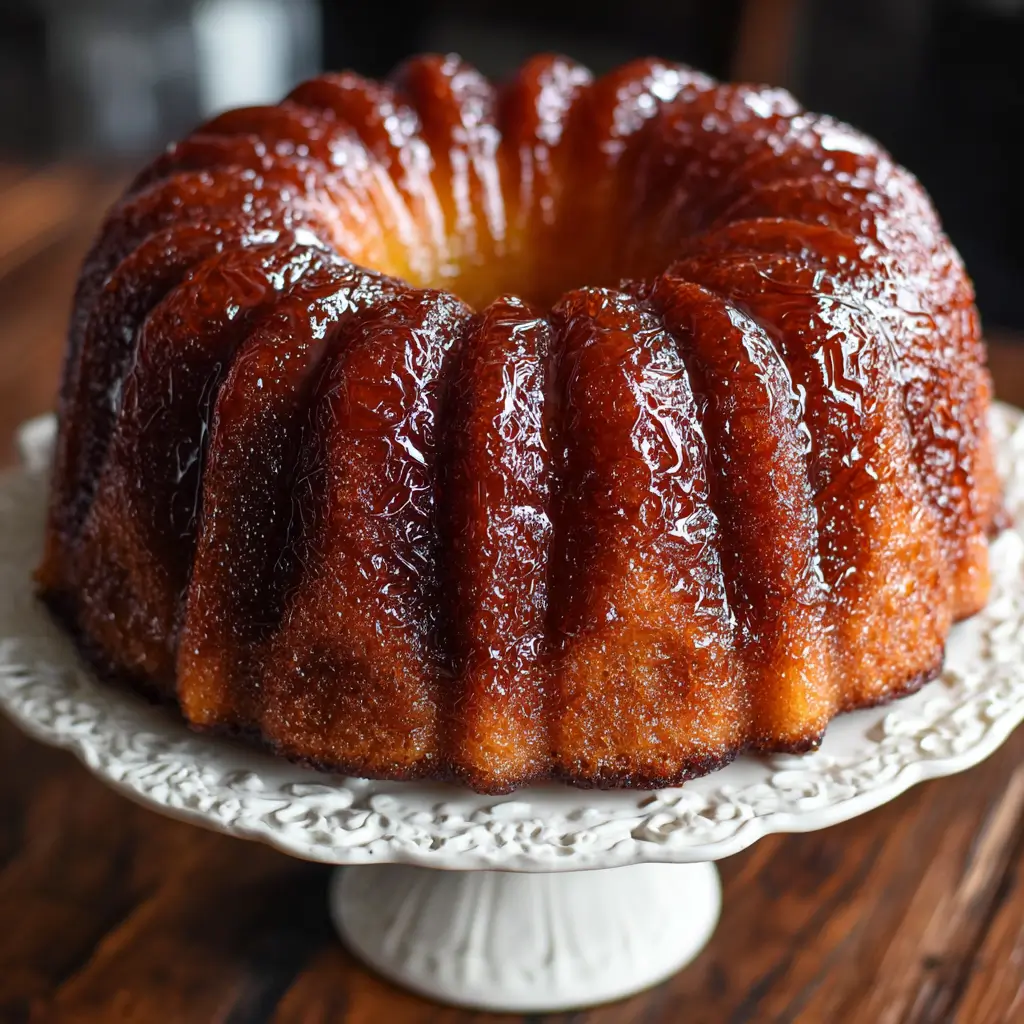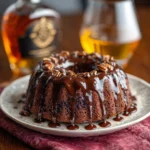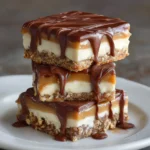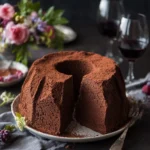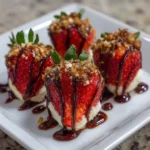Rum Cake: A Rich, Moist Dessert Steeped in Tradition
The rum cake is a beloved dessert with roots stretching across continents and centuries. Originating from the Caribbean islands, where sugarcane and rum production flourished during colonial times, this decadent treat emerged as a way to preserve fruit and enhance flavor using the region’s most abundant spirit—rum. Over time, rum cake became synonymous with celebration, often served during holidays such as Christmas, weddings, and festivals. In places like Puerto Rico, Jamaica, and the Virgin Islands, each family has its own treasured version of the recipe, passed down through generations. The cake’s evolution reflects not only local tastes but also cultural exchange—European baking traditions meeting tropical ingredients. Today, rum cake enjoys global popularity, appreciated for its deep flavor, moist texture, and intoxicating aroma that fills any kitchen during preparation.
The History of Rum Cake
Rum cake traces its origins back to the 17th century when European settlers arrived in the Caribbean. With an abundance of molasses—a byproduct of sugar refining—they began distilling rum, which quickly became a staple ingredient in cooking and baking. Early versions of rum cake were inspired by British puddings and fruitcakes, adapted using locally available dried fruits soaked in rum. These cakes were dense, rich, and designed to last for weeks, making them ideal for long sea voyages or holiday storage. In many Caribbean cultures, it was customary to begin preparing rum cake months in advance of Christmas, allowing the flavors to deepen over time with additional rum basting. As trade routes expanded, so did the popularity of rum cake, influencing desserts in Latin America, the Southern United States, and even parts of Europe. In modern times, commercial producers have popularized “dark rum cake” as a gift item, especially from islands like St. Lucia and Tortola, where they are wrapped in festive packaging and shipped worldwide.
Ingredients Breakdown: What Makes Rum Cake Special
The magic of a perfect rum cake lies in its carefully balanced ingredients, each contributing to its signature richness and moisture. Let’s break them down:
- Butter: High-quality unsalted butter provides a creamy base and contributes to the cake’s tender crumb. It should be softened to room temperature for optimal creaming.
- Sugar: Granulated sugar adds sweetness and helps aerate the batter when beaten with butter and eggs. Some recipes use brown sugar for a deeper molasses flavor.
- Eggs: Large eggs act as binders and add structure while contributing to the cake’s moistness and golden color.
- Flour: All-purpose flour gives the cake its structure. Sifting ensures a light texture and prevents lumps.
- Baking Powder & Salt: Baking powder leavens the cake, helping it rise, while salt enhances all the flavors.
- Milk or Buttermilk: Adds moisture and tenderness. Buttermilk introduces a slight tang that balances the sweetness.
- Rum: The star ingredient. Dark or aged rum is preferred for its robust, caramel-like notes. Light rum can be used for a milder taste.
- Dried Fruits: Commonly includes raisins, currants, cherries, citron, and pineapple. These are typically soaked in rum for days—or even months—to plump up and absorb flavor.
- Nuts (optional): Chopped walnuts, pecans, or almonds add crunch and depth.
- Vanilla Extract: Enhances overall flavor and complements the rum beautifully.
- Spices (optional): Cinnamon, nutmeg, allspice, or cloves may be added for warmth, especially in holiday versions.
The synergy between rum-soaked fruit and the buttery cake base creates a dessert that’s both indulgent and complex in flavor.
Step-by-Step Recipe: How to Make the Perfect Rum Cake
Follow this detailed guide to bake a moist, flavorful rum cake that will impress at any gathering.
Preparation (1 day ahead – recommended)
- In a glass jar or non-reactive container, combine 2 cups mixed dried fruit (raisins, currants, chopped cherries, candied pineapple) with ½ cup dark rum.
- Cover and let soak at room temperature for at least 24 hours, shaking occasionally. For deeper flavor, soak for up to 1 month, topping up with rum if needed.
On Baking Day
- Preheat oven: 325°F (165°C). Grease and flour a bundt pan or tube pan. Optionally, line the bottom with parchment paper.
- Cream butter and sugar: In a large bowl, beat 1 cup (2 sticks) softened unsalted butter with 1 ½ cups granulated sugar until light and fluffy (about 5 minutes).
- Add eggs one at a time: Beat well after each addition. Stir in 2 teaspoons vanilla extract.
- Combine dry ingredients: In a separate bowl, whisk together 2 ½ cups all-purpose flour, 1 ½ teaspoons baking powder, and ½ teaspoon salt.
- Alternate adding dry ingredients and milk: Begin and end with dry ingredients. Mix on low speed just until combined—do not overmix.
- Fold in soaked fruit and nuts: Drain excess rum from the fruit (reserve liquid), then gently fold fruit and ½ cup chopped pecans into the batter.
- Pour into pan: Spread evenly and smooth the top.
- Bake: 60–75 minutes, or until a toothpick inserted comes out clean. If the top browns too quickly, cover loosely with aluminum foil.
- Cool: Let rest in the pan for 15 minutes, then invert onto a wire rack to cool completely.
Rum Syrup (Essential for Moisture)
- In a saucepan, combine ½ cup granulated sugar with ½ cup water. Heat until sugar dissolves.
- Remove from heat and stir in ¼ cup dark rum (or more to taste).
- While the cake is still warm (after 15 minutes of cooling), poke holes all over with a skewer and brush or spoon the warm syrup generously over the surface.
- Let the cake absorb the syrup completely before serving. This step can be repeated the next day for extra moisture.
Tips for the Best Rum Cake
- Aging the fruit: Soak dried fruit in rum for at least 24 hours; longer soaking (weeks or months) intensifies flavor and juiciness.
- Use room temperature ingredients: Ensures even mixing and a smoother batter.
- Don’t overbake: Check at 60 minutes. Overbaking leads to dryness, even with syrup.
- Double baste with syrup: Apply rum syrup once when warm, and again the next day for maximum moisture.
- Storage: Store in an airtight container at room temperature for up to 1 week. Refrigerate for up to 2 weeks or freeze for up to 3 months. Always re-brush with warmed rum syrup before serving if stored.
- Alcohol content: While some alcohol evaporates during baking, a significant amount remains—especially after syrup application. Serve responsibly.
- Pan choice: A bundt pan not only looks elegant but allows even heat distribution. Make sure to grease thoroughly to prevent sticking.
Variations and Customizations
Rum cake is incredibly versatile. Here are creative ways to customize your recipe:
- Lime Rum Cake: Add zest of 2 limes to the batter and use lime juice in the syrup. Replace dark rum with coconut or spiced rum for a tropical twist.
- Black Forest Rum Cake: Soak cherries in cherry brandy and dark rum. Add cocoa powder to the batter and layer with whipped cream and chocolate ganache.
- Gluten-Free Rum Cake: Substitute all-purpose flour with a gluten-free flour blend. Ensure it contains xanthan gum or add ½ tsp for structure.
- Vegan Rum Cake: Use plant-based butter, flax eggs (1 tbsp ground flax + 3 tbsp water per egg), and almond or oat milk. Check rum for animal-based filtration (most are vegan-friendly).
- Mini Rum Cakes: Bake in muffin tins for individual servings. Reduce baking time to 20–25 minutes.
- Boozy Trifle: Cube leftover rum cake and layer with custard, whipped cream, and more rum syrup for a show-stopping dessert.
- Orange-Rum Cake: Soak fruit in orange-infused rum and add orange zest to the batter and syrup.
- Spiced Rum Cake: Add 1 tsp pumpkin pie spice or homemade spice mix (cinnamon, clove, nutmeg, ginger) to the dry ingredients.
Health Considerations and Nutritional Value
While undeniably delicious, rum cake is a high-calorie, high-sugar dessert best enjoyed in moderation. Here’s a general nutritional breakdown per slice (1/12 of a standard cake):
- Calories: ~450–550
- Total Fat: 20–25g (mostly from butter)
- Saturated Fat: 12–15g
- Carbohydrates: 60–70g
- Sugars: 40–50g (from added sugar and dried fruit)
- Protein: 4–6g (from eggs and flour)
- Alcohol: Varies depending on rum quantity—approximately 1–2 tablespoons per slice after baking and soaking.
Considerations:
- Alcohol Content: Not suitable for children, pregnant women, or those avoiding alcohol. Most of the alcohol does not fully cook off, especially with post-bake soaking.
- Sugar Levels: High glycemic impact. Diabetics should consume sparingly or explore sugar substitutes (though results may vary in texture).
- Allergens: Contains dairy, eggs, wheat, and possibly nuts. Always label accordingly when serving.
- Dried Fruit: Naturally high in sugars and sulfites (in some brands); opt for organic, unsulfured varieties when possible.
For a slightly healthier version, consider reducing sugar by 25%, using whole wheat pastry flour, and incorporating applesauce or mashed banana to reduce butter. However, these changes may alter the traditional texture and shelf life.
Ingredients
- 2 cups mixed dried fruit (raisins, currants, cherries, pineapple)
- ½ cup dark rum (for soaking fruit)
- 1 cup (2 sticks) unsalted butter, softened
- 1 ½ cups granulated sugar
- 4 large eggs
- 2 teaspoons pure vanilla extract
- 2 ½ cups all-purpose flour
- 1 ½ teaspoons baking powder
- ½ teaspoon salt
- ½ cup milk or buttermilk
- ½ cup chopped pecans or walnuts (optional)
- ½ cup dark rum (for syrup)
- ½ cup granulated sugar (for syrup)
- ½ cup water (for syrup)
Directions
- Soak the fruit: Combine dried fruit and ½ cup dark rum in a sealed container. Let sit at room temperature for at least 24 hours, preferably longer.
- Preheat oven: 325°F (165°C). Grease and flour a 10-inch bundt pan.
- Cream butter and sugar: Using a stand mixer or hand mixer, beat butter and sugar until pale and fluffy (5 mins).
- Add eggs and vanilla: Beat in eggs one at a time, scraping bowl as needed. Mix in vanilla.
- Whisk dry ingredients: In another bowl, combine flour, baking powder, and salt.
- Alternate additions: Add one-third of flour mixture to butter mix, followed by half the milk. Repeat, ending with flour. Mix until just combined.
- Fold in fruit and nuts: Drain soaked fruit (reserve rum), then gently fold into batter with nuts.
- Fill pan: Pour batter into prepared pan and smooth top.
- Bake: 60–75 minutes, until a toothpick comes out clean.
- Cool: Rest in pan 15 minutes, then transfer to wire rack.
- Make syrup: Boil sugar and water until dissolved. Remove from heat; stir in ½ cup dark rum.
- Soak cake: While cake is warm, poke holes and brush generously with warm syrup. Cool completely.
- Optional re-soak: Next day, warm remaining syrup (if any) and apply again for extra moisture.
- Serve: Dust with powdered sugar, serve plain, or with whipped cream or ice cream.
FAQ
- Soak the fruit: Combine dried fruit and ½ cup dark rum in a sealed container. Let sit at room temperature for at least 24 hours, preferably longer.
- Preheat oven: 325°F (165°C). Grease and flour a 10-inch bundt pan.
- Cream butter and sugar: Using a stand mixer or hand mixer, beat butter and sugar until pale and fluffy (5 mins).
- Add eggs and vanilla: Beat in eggs one at a time, scraping bowl as needed. Mix in vanilla.
- Whisk dry ingredients: In another bowl, combine flour, baking powder, and salt.
- Alternate additions: Add one-third of flour mixture to butter mix, followed by half the milk. Repeat, ending with flour. Mix until just combined.
- Fold in fruit and nuts: Drain soaked fruit (reserve rum), then gently fold into batter with nuts.
- Fill pan: Pour batter into prepared pan and smooth top.
- Bake: 60–75 minutes, until a toothpick comes out clean.
- Cool: Rest in pan 15 minutes, then transfer to wire rack.
- Make syrup: Boil sugar and water until dissolved. Remove from heat; stir in ½ cup dark rum.
- Soak cake: While cake is warm, poke holes and brush generously with warm syrup. Cool completely.
- Optional re-soak: Next day, warm remaining syrup (if any) and apply again for extra moisture.
- Serve: Dust with powdered sugar, serve plain, or with whipped cream or ice cream.
FAQ
Can I make rum cake without alcohol?
Yes, though it won’t be authentic. Substitute rum with strong brewed tea, apple juice, or grape juice mixed with 1 tsp vinegar. Add 1 extra tsp vanilla to compensate for flavor loss.
How long does rum cake last?
Stored airtight at room temperature: 1 week. Refrigerated: 2 weeks. Frozen: 3 months. The flavor often improves after a few days.
Can I use light rum instead of dark rum?
Yes, but dark rum offers richer, deeper flavor with notes of caramel and spice. Light rum is milder and works well in citrusy variations.
Why is my rum cake dry?
Common causes: overbaking, insufficient syrup, or skipping the fruit-soaking step. Always apply warm rum syrup to a warm cake for best absorption.
Can I get drunk from eating rum cake?
It’s unlikely from a single slice, but because the cake absorbs rum both pre- and post-bake, sensitive individuals may feel effects. Avoid giving to children or those avoiding alcohol.
Can I bake this in a different pan?
Yes. Use two 9-inch round pans (reduce time to 45–55 mins) or a 9×13-inch pan (50–60 mins). Adjust syrup quantity accordingly.
Can I use fresh fruit?
Not recommended. Fresh fruit contains too much moisture and can make the cake soggy. Stick to dried or candied fruit for proper texture.
Summary
Rum cake is a luxuriously moist, deeply flavored dessert rooted in Caribbean tradition, combining rum-soaked dried fruits with a buttery sponge and finished with a boozy syrup soak. Whether enjoyed during the holidays or as a year-round indulgence, it’s a timeless treat that marries history, flavor, and craftsmanship in every bite.
